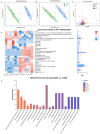Maternal Malic Acid May Ameliorate Oxidative Stress and Inflammation in Sows through Modulating Gut Microbiota and Host Metabolic Profiles during Late Pregnancy
- PMID: 38397851
- PMCID: PMC10886295
- DOI: 10.3390/antiox13020253
Maternal Malic Acid May Ameliorate Oxidative Stress and Inflammation in Sows through Modulating Gut Microbiota and Host Metabolic Profiles during Late Pregnancy
Abstract
Sows suffer oxidative stress and inflammation induced by metabolic burden during late pregnancy, which negatively regulates reproductive and lactating performances. We previously found that L-malic acid (MA) alleviated oxidative stress and inflammation and improved reproductive performances in sows. However, the mechanism underlying the MA's positive effects remains unexplored. Here, twenty Large White × Landrace sows with similar parity were randomly divided into two groups and fed with a basal diet or a diet supplemented with 2% L-malic acid complex from day 85 of gestation to delivery. The gut microbiome, fecal short-chain fatty acids, and untargeted serum metabolome were determined. Results showed that Firmicutes, Bacteroidota, and Spirochaetota were the top abundant phyla identified in late pregnancy for sows. Maternal MA supplementation modulated the composition but not the richness and diversity of gut microbiota during late pregnancy. Correlation analysis between gut microbiota and antioxidant capacity (or inflammation indicators) revealed that unclassified_f_Ruminococcaceae, unclassified_f_Lachnospiraceae, UCG-002, norank_f_norank_o_RF3, and Lactobacillus might play a role in anti-oxidation, and Lachnospiraceae_XPB1014_group, Lachnospiraceae_NK4A136_group, UCG-002, unclassified_f_Ruminococcaceae, Candidatus_Soleaferrea, norank_f_UCG-010, norank_f_norank_o_RF39, and unclassified_f_Lachnospiraceae might be involved in the anti-inflammatory effect. The improved antioxidant and inflammation status induced by MA might be independent of short chain fatty acid changes. In addition, untargeted metabolomics analysis exhibited different metabolic landscapes of sows in the MA group from in the control group and revealed the contribution of modified amino acid and lipid metabolism to the improved antioxidant capacity and inflammation status. Notably, correlation results of gut microbiota and serum metabolites, as well as serum metabolites and antioxidant capacity (or inflammation indicators), demonstrated that differential metabolism was highly related to the fecal microorganisms and antioxidant or inflammation indicators. Collectively, these data demonstrated that a maternal dietary supply of MA can ameliorate oxidative stress and inflammation in sows through modulating gut microbiota and host metabolic profiles during late pregnancy.
Keywords: L-malic acid; gut microbiota; late pregnancy; metabolic; sow.
Conflict of interest statement
The authors declare no conflicts of interest.
Figures






Similar articles
-
Impact of sugar beet pulp and wheat bran on serum biochemical profile, inflammatory responses and gut microbiota in sows during late gestation and lactation.J Anim Sci Biotechnol. 2021 Apr 20;12(1):54. doi: 10.1186/s40104-021-00573-3. J Anim Sci Biotechnol. 2021. PMID: 33879267 Free PMC article.
-
Maternal consumption of l-malic acid enriched diets improves antioxidant capacity and glucose metabolism in offspring by regulating the gut microbiota.Redox Biol. 2023 Nov;67:102889. doi: 10.1016/j.redox.2023.102889. Epub 2023 Sep 19. Redox Biol. 2023. PMID: 37741046 Free PMC article.
-
Fermented Bamboo Fiber Improves Productive Performance by Regulating Gut Microbiota and Inhibiting Chronic Inflammation of Sows and Piglets during Late Gestation and Lactation.Microbiol Spectr. 2023 Jun 15;11(3):e0408422. doi: 10.1128/spectrum.04084-22. Epub 2023 Apr 12. Microbiol Spectr. 2023. PMID: 37042787 Free PMC article.
-
Plant-based antioxidant peptides: impact on oxidative stress and gut microbiota.Crit Rev Food Sci Nutr. 2025 Apr 12:1-24. doi: 10.1080/10408398.2025.2490270. Online ahead of print. Crit Rev Food Sci Nutr. 2025. PMID: 40219794 Review.
-
Anti-Inflammatory and Antioxidative Phytogenic Substances against Secret Killers in Poultry: Current Status and Prospects.Vet Sci. 2023 Jan 14;10(1):55. doi: 10.3390/vetsci10010055. Vet Sci. 2023. PMID: 36669057 Free PMC article. Review.
Cited by
-
Dietary resveratrol improves immunity and antioxidant defense in ewes by regulating the rumen microbiome and metabolome across different reproductive stages.Front Immunol. 2024 Oct 11;15:1462805. doi: 10.3389/fimmu.2024.1462805. eCollection 2024. Front Immunol. 2024. PMID: 39464877 Free PMC article.
-
Metabolomics reveals the potential metabolic mechanism of infliximab against DSS-induced acute and chronic ulcerative colitis.Naunyn Schmiedebergs Arch Pharmacol. 2024 Nov;397(11):8815-8824. doi: 10.1007/s00210-024-03201-9. Epub 2024 Jun 7. Naunyn Schmiedebergs Arch Pharmacol. 2024. PMID: 38847830
-
Chromium yeast promotes milk protein synthesis by regulating ruminal microbiota and amino acid metabolites in heat-stressed dairy cows.Anim Nutr. 2024 Nov 28;20:120-130. doi: 10.1016/j.aninu.2024.11.003. eCollection 2025 Mar. Anim Nutr. 2024. PMID: 39967697 Free PMC article.
-
Bifidobacterium longum JBLC-141 alleviates hypobaric hypoxia-induced intestinal barrier damage by attenuating inflammatory responses and oxidative stress.Front Microbiol. 2024 Dec 17;15:1501999. doi: 10.3389/fmicb.2024.1501999. eCollection 2024. Front Microbiol. 2024. PMID: 39741588 Free PMC article.
-
Effect of host breeds on gut microbiome and fecal metabolome in commercial pigs.BMC Vet Res. 2024 Oct 10;20(1):458. doi: 10.1186/s12917-024-04308-0. BMC Vet Res. 2024. PMID: 39390513 Free PMC article.
References
-
- Black J., Mullan B., Lorschy M., Giles L. Lactation in the sow during heat stress. Livest. Prod. Sci. 1993;35:153–170. doi: 10.1016/0301-6226(93)90188-N. - DOI
Grants and funding
LinkOut - more resources
Full Text Sources

